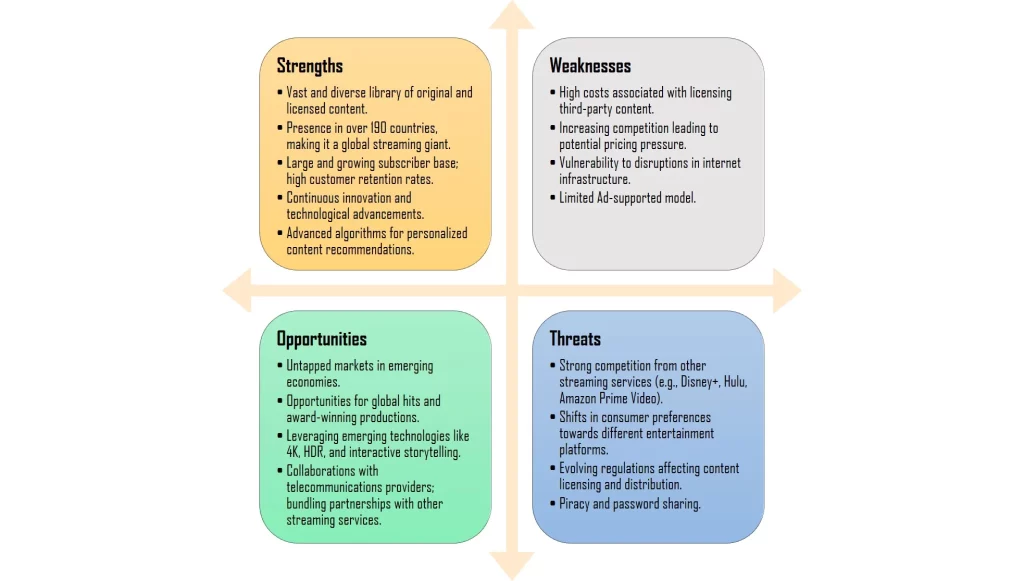
Below is a sample
SWOT analysis essay on Netflix, Inc. This example is intended to help students write better business analysis essays.
Netflix Inc. SWOT Analysis Essay
SWOT Analysis Essay Outline: Netflix Inc.
- Introduction:
- Company: Netflix Inc.
- Date of Establishment: August 29, 1997
- Founders: Reed Hastings, Marc Randolph
- Industry: Media Entertainment
- Key People:
- Reed Hastings (executive chairman)
- Ted Sarandos (co-CEO)
- Greg Peters (co-CEO)
- Headquarters: Los Gatos, California, United States
- No. of Employees: 12,800 (2022)
- Type: Public
- Ticker Symbol: NFLX (NASDAQ)
- Revenue: US $31.6 billion (2022)
- Net Income: US $4.5 billion (2022)
- Competitors: Amazon.com Inc., Warner Bros., Paramount Global, DISH Network Corp.
- Strengths:
- Content Library:
- Vast and diverse library of original and licensed content.
- Strong emphasis on exclusive and award-winning productions.
- Global Reach:
- Presence in over 190 countries, making it a global streaming giant.
- Localization of content for various international markets.
- Subscriber Base:
- Large and growing subscriber base.
- High customer retention rates.
- Data-Driven Recommendations:
- Advanced algorithms for personalized content recommendations.
- Utilization of user data for content production decisions.
- Weaknesses:
- Content Licensing Costs:
- High costs associated with licensing third-party content.
- Dependence on external studios for a significant portion of its library.
- Competitive Pricing Pressure:
- Increasing competition leading to potential pricing pressure.
- Balancing the need for affordable plans while maintaining content quality.
- Dependence on Internet Infrastructure:
- Vulnerability to disruptions in internet infrastructure.
- Limited accessibility in regions with poor internet connectivity.
- Limited Ad-Supported Model:
- Relying primarily on subscription-based revenue.
- Potential missed revenue opportunities from an ad-supported model.
- Opportunities:
- International Expansion:
- Untapped markets in emerging economies.
- Tailoring content to diverse international audiences.
- Original Content Production:
- Continued investment in original content creation.
- Opportunities for global hits and award-winning productions.
- Technological Advancements:
- Leveraging emerging technologies like 4K, HDR, and interactive storytelling.
- Enhancing the user experience through technological innovations.
- Strategic Partnerships:
- Collaborations with telecommunications providers.
- Bundling partnerships with other streaming services.
- Threats:
- Intense Competition:
- Strong competition from other streaming services (e.g., Disney+, Hulu, Amazon Prime Video).
- Pressure to acquire and retain exclusive content.
- Changing Consumer Preferences:
- Shifts in consumer preferences towards different entertainment platforms.
- Adapting to new trends in content consumption.
- Regulatory Challenges:
- Evolving regulations affecting content licensing and distribution.
- Compliance challenges in different regions.
- Piracy and Password Sharing:
- Threats from illegal streaming and content piracy.
- Impact of widespread password sharing on revenue.
- Conclusion:
- Summary of key findings from the SWOT analysis.
- Implications for Netflix’s strategic planning and future actions.
This SWOT analysis outline provides a framework for assessing Netflix’s internal strengths and weaknesses, as well as external opportunities and threats in the streaming and entertainment industry.

